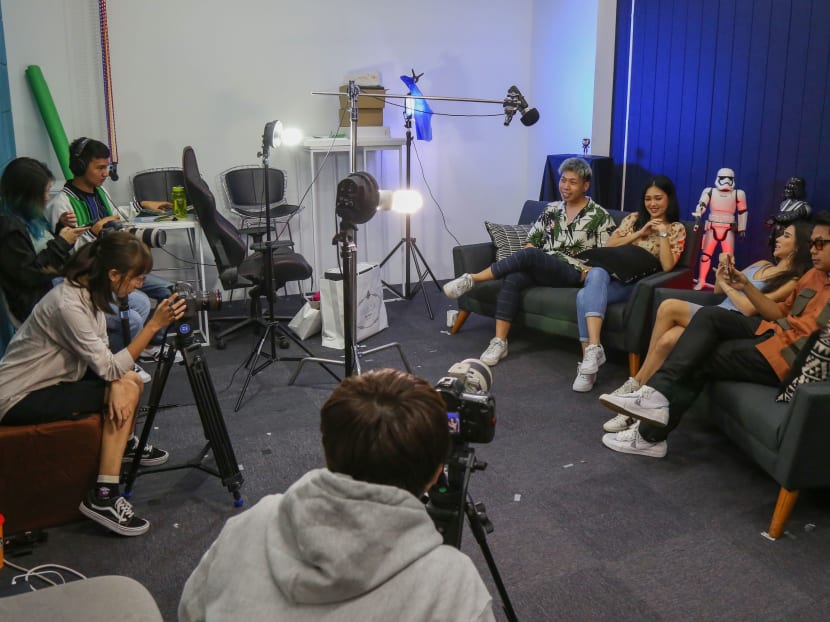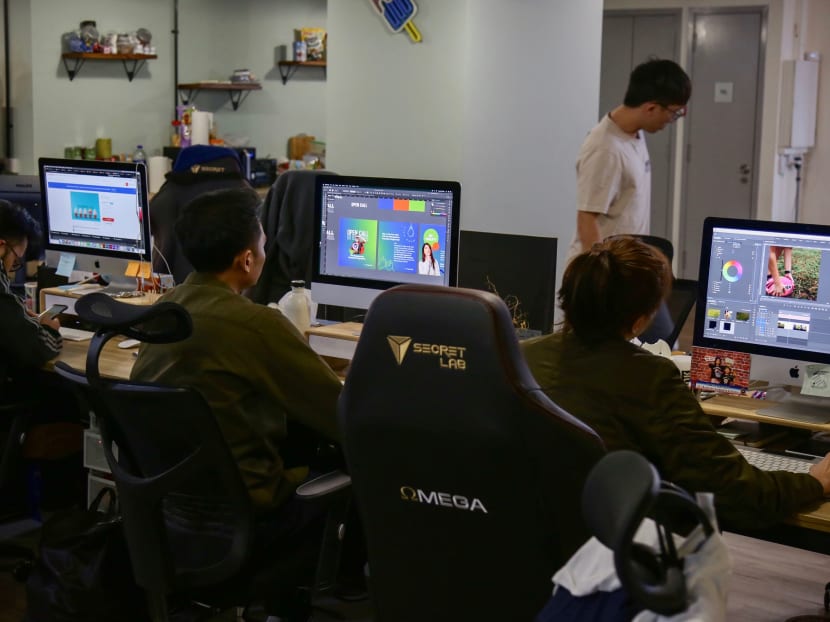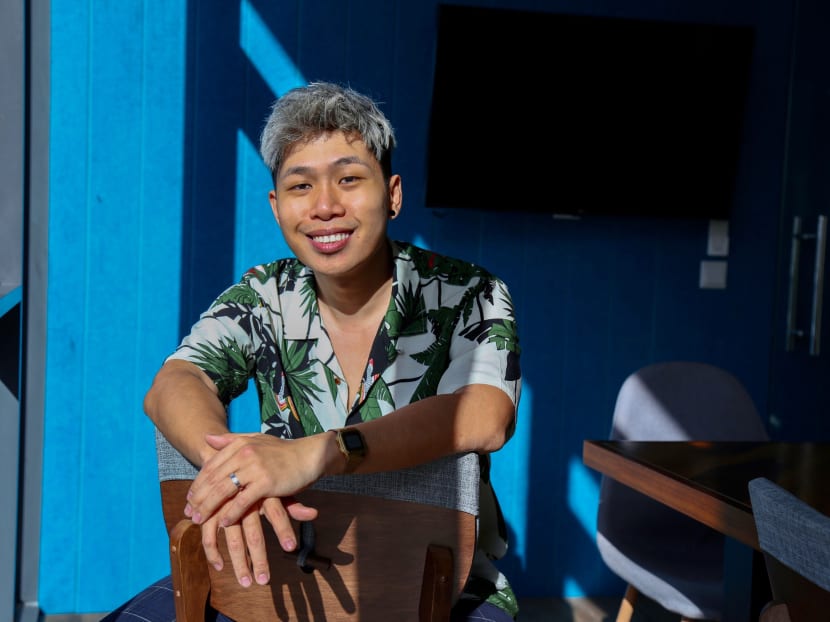The Big Read: Power, fame and fortune — a glimpse into S’pore’s lucrative YouTube industry
SINGAPORE — When it comes to making money, Singapore’s biggest YouTube stars are not in the same stratosphere as their counterparts in some other markets. Still, they are doing not too badly themselves — the bigger players are raking in the millions. But beneath the fame and fortune, there is a not-so-pretty side.

(Fourth from right) Mr Johnathan Chua, seen here on set during a filming session for one of the episodes of the online talk show, Real Talk.
SINGAPORE — With her hair tightly pulled back in a ponytail, Rui looks like a typical 15-year-old with a quiet and studious demeanour — not quite what one would expect of a YouTube personality.
In about 15 months, Rui, who declined to have her pictures taken or her full name published, has attracted almost 17,000 subscribers to her “spudstudy” channel.
So far, she has put up 29 videos showing her putting together her study notes, tidying up her desk, giving tips on how to have better handwriting, as well as her travel vlogs, among other things — all without showing her face.
One of her first few videos, which she put up during the December holidays in 2018, racked up 400,000 views. The three-minute video titled “day in my life : holiday edition” shows her going about routine activities such as taking care of her pet guinea pigs and preparing her meals.
Requests for endorsement are already trickling in, from as far away as the United Kingdom (UK).
The first request came from a tuition centre in the UK, while the second was from a video editing website. She did not take up the first one as she suspects that it is a scam while she turned down the other as the company wanted her to reveal her face.
She is currently talking to a firm which wants her to mention a PDF document converter in one of her videos in return for US$70 (S$94.50). In the meantime, she has earned a couple of hundred dollars from AdSense, a program run by Google that allows advertisements to be run on YouTube videos.
Despite her modest success on YouTube, Rui said she has no interest in trying to carve out a career by making videos, like what many YouTubers aspire to.
Speaking to TODAY at a cafe after school earlier this week, she said her interest lies in science. “YouTube is a place where I relax during study breaks, get views and have fun, but I don’t take it as a career,” she added.
Rui is earning peanuts compared to the eye-popping amounts that bona fide YouTube stars overseas as well as in Singapore make. But every YouTuber has to start somewhere.
Ryan Kaji, who was born in Texas in the United States, started unboxing toys on YouTube when he was just three.
Like Rui, Ryan started out with simple videos — his first shows him playing with Lego bricks.
Five years on, Ryan is earning millions.
In fact, he was named the highest paid YouTube star in Forbes’ list released last month, having earned US$26 million last year reviewing toys.
In second spot was the five-man sports crew, known as Dude Perfect, which specialises in intricate trick shots. They made US$20 million.
Rounding up the top three was Russian-American Anastasia Radzinskaya, 5. She earned US$18 million with videos that mainly feature her playing with her dad, according to Forbes. She now works with toy and food brands.
Singapore’s biggest YouTube stars are not in the same stratosphere but they are doing not too badly themselves.
There is little publicly available information about the YouTube industry in Singapore, except that the hours of content uploaded from YouTube channels here increased by over 50 per cent between 2018 and last year.
Nevertheless, Mr Tan Jianhao, 26, is regarded as Singapore’s top YouTuber with 3.8 million subscribers to his channel. The chief executive officer and founder of Titan Digital Media reportedly earns a six-figure sum annually although industry observers believe the amount to be higher.
Another major player, Night Owl Cinematics (NOC), told TODAY that their annual revenue is a seven-figure amount.
OUT OF THE BEDROOM, INTO THE BIG TIME
Official figures on YouTube’s earnings are not available, although estimates for 2019 ranged between US$16 billion and US$25 billion. As such, the size of the YouTube industry in Singapore is a mystery as well.
But while there was the perception just five years ago that YouTubers should get a real job, several homegrown YouTubers have managed to break out of their bedroom workspaces to build thriving businesses with million-dollar revenues and dozens of employees.
Having built a brand on YouTube, many of them have established presence on other social media platforms as well.
According to industry players, the “Big Four” of Singapore’s YouTube industry are Titan Digital Media, NOC, Wah!Banana, and Clicknetwork.

Mostly run by millennials in the late 20s or early 30s, these channels have hit the big time.
Together, they produce most of the comedy sketches, vlogs, and lifestyle videos that many young Singaporeans are glued to.
They are getting a big chunk of advertising and marketing budgets as well — both from government agencies and private companies, with quotations of about S$30,000 or more for a branded video.
Clients are turning to them, instead of traditional production houses as the YouTubers offer quick turnarounds and “guaranteed” views.
Among the Big Four, Mr Tan Jianhao leads the pack, charging S$38,000 for branded content and S$20,000 for a vlog in 2018 when he had 1.4 million subscribers on YouTube, according to his June 2018 rate card seen by TODAY.
Today, with nearly four million subscribers, it is estimated that Mr Tan Jianhao is charging about S$50,000 for a video on YouTube.
He did not respond to TODAY’s query on his latest rates, but it could be seen from his September 2019 Instagram rate card that his rates had more than doubled in 15 months.
With 581,000 Instagram followers in September 2019, he charged S$4,400 per photo post and S$10,000 per video post, up from S$1,800 and S$4,500 respectively in June 2018.
The September 2019 rate card also showed that Mr Tan Jianhao’s five-year-old dog, a Pomeranian called BunCha, commanded rates of S$2,500 per video and S$1,200 per photo on Instagram. BunCha’s account, babybuncha, currently has about 132,000 followers.
Such rates for Singapore’s top YouTubers are by no means scaring clients off.
NOC co-founder Sylvia Chan, 32, said she has to be more selective with clients as her firm’s YouTube channel — which has about 967,000 subscribers — receives 50 to 150 enquiries a week.
The channel’s median per-video income ranges between S$30,000 and S$40,000, said Ms Chan who runs the business with her husband, Ryan Tan, 31.
Nevertheless, Ms Chan said their business expenses including manpower and equipment costs are substantial, running into the millions.
FEW SAW IT COMING
When they first started their channel in 2011, little did they know how big the industry would become.
At that time, the world’s most-subscribed YouTuber, PewDiePie, had fewer than 60,000 subscribers and Ryan, the top earning YouTube star globally, was not even born yet.
“There was no money in this industry,” said Ms Chan. “There were a couple of years where I just earned a few thousand dollars a year. A lot of people would have given up by then, but for us, I thought as long as we are not that poor… we were not in debt, and you are doing something that you love, it is okay.”
According to the YouTubers, the marketing dollars here started pouring in about three years ago.
For NOC, 2018 was a standout year where its revenue grew five to 10 times, said Ms Chan.
“I started… to deconstruct this business… so that we could see for ourselves the avenues where we need to be more professional in and areas that we need to study a lot more on,” she said.
The university dropout — who was reading economics and sociology at the University of London (Singapore) — and her husband, a former restaurateur, started taking a more active approach towards growing NOC’s business from around 2015.
“We researched. We tried new things,” she said. “You start to realise that this is not a joke anymore… It (became) a legitimate business.”
Now, NOC has about 40 people on its payroll, 25 of whom are full-time employees.

Over at Wah!Banana, which has more than one million subscribers, co-founder and producer Xiong Lingyi told TODAY that the channel’s revenue grew by 50 per cent last year, and its clientele has grown beyond consumer goods companies.
It now hires seven full-time staff and engages about a dozen talents.
Ms Xiong, 31, said: “We are not known for having great production value, but we are very, very fast.”
Noting that her channel can produce branded content as quickly as within two days, she added that it also has “well-known talents”.
She pointed out that there is “no shortage of money” in the industry, given that many multinational corporations have their headquarters in Singapore.
“A lot of people hire us for the audience we have in this region,” she said.
When Wah!Banana started out in 2012, 90 per cent of its audience were from Singapore. The proportion has dropped to less than 40 per cent today, as they gain audiences in Malaysia, Indonesia, Australia, India and the Philippines.
Based on TODAY’s interviews with YouTubers, such a trend is common for many of them as well.
COMPETITION HOTS UP, AS RATES ‘NORMALISE’
The explosive growth of the lucrative YouTube industry has drawn new players who were previously focused on other platforms.
They include TheSmartLocal and SGAG’s Nubbad TV, which have about 264,000 and 72,300 subscribers respectively.
A relatively new entrant is a 30-man content agency and media group, Grvty Media.
In 2018, it started producing a risque online talk show Real Talk, which helped its Millennials of Singapore channel grow rapidly.
The talk show has featured topics such as how to “talk dirty” and the hosts had also shared how they lost their virginity.
A popular episode saw DJ and social media personality Jade Rasif, 25, letting her co-hosts try her breast milk.
Grvty Media co-founder Johnathan Chua, 30, who is one of the four co-hosts of Real Talk, said clients go to them for their different appeal.
One of Real Talk’s latest and biggest clients is ride-hailing company Grab, which sponsored an episode where the co-hosts discussed their relationship with parents.
Towards the end of the unscripted episode, co-host Dew Francis, 28, who is also Grvty’s business development manager, introduced Grab into the discussion when he said that his mother would get him to send her home, as she knew that two destinations could be keyed into one trip order.
At the end of the show, the co-hosts reveal that Grab had sponsored the episode.

Grvty media director Daniel Lim, 28, said more clients are now aware of the power of soft sell.
At the same time, clients are becoming increasingly savvy.
“When we first started, there were a lot of cowboy players who were charging stupid amounts of money that was very, very hard to justify. There was no sense of normalisation,” said Mr Chua, who was previously from social media agency Gushcloud.
Indeed, a YouTuber in his 20s who declined to be named, told TODAY that about five to six years ago, he was shocked to be offered S$35,000 by his first client to conceptualise and produce a series of seven three- to five-minute videos for a local brand. His channel was only one year old at that time and had about 10,000 subscribers.
“I thought it was S$5,000 for the whole project but when they say S$5,000 per video, I went like ‘Huh!’,” he said. Today, his channel has more than 70,000 subscribers and he charges about S$2,000 for a video.
SEX SELLS
The success of some of Singapore’s top YouTubers has recently been attracting criticism of their content.
Among other things, they have been criticised for being unoriginal and relying on listicles and eye candy — young, attractive women wearing sexy outfits — to draw eyeballs.
In the middle of last year, content creator Sneaky Sushii sought to enter the industry with a splash, by putting up a video roasting some of Singapore’s most prominent YouTubers.
The video titled “How not to be a Singaporean YouTuber” was taken off YouTube due to a copyright claim by NOC over images of bikini-clad girls featured in Sneaky Sushii’s clip which were taken from NOC’s videos.
Mr Tan Jianhao also posted a series of Instagram stories in response. Defending his heavy use of listicles, he said: “This is YouTube. I am not going to spend weeks on a video then leave it there and hope nobody watches lol.”
He added: “Viewers of the channel have seen how much our content evolved over the years, and the list is simply just a structure. And I don’t plan to change that anytime soon… Don’t hate the player, hate the game.”
Asked about Sneaky Sushii’s criticism on NOC’s use of girls, Ms Chan told TODAY that one of the pictures featured was a screenshot from NOC’s travelogues to Phuket. She added, “If you go to Phuket, what do you want us to wear?”
Ms Chan pointed out that the top shows produced by NOC were “not the trashy talk shows” but “legit talk shows” — such as her recent interview with a tech entrepreneur on how he built his business.
Still, at least two YouTubers whom TODAY spoke to admitted that the use of eye candy is a deliberate strategy in the industry to optimise view counts.
A YouTuber in his late 20s who declined to be named said he used the tactic once on his channel, and managed to get more than 300,000 views.
“I was like ‘woah, that easy?’ Of course, it was funny content as well, but girls are (half the battle won) — the first step of making a successful YouTube video in Singapore or anywhere else,” he said.
However, junior college student Jamie Lynn, 17, who has stopped watching Singapore YouTubers even though she used to as a child, said she is “disgusted and disturbed” by the use of sexualised images to draw viewers.
“It will breed a very predatory kind of culture... It makes it look like it’s okay to use women’s bodies for clickbait and for boys to think of girls like that,” she said.
In general, she now finds that the comedy sketches by Singapore YouTubers are “too exaggerated” and the jokes “are not funny anymore”.
THE POWER STRUCTURE: EITHER YOU’RE IN OR YOU’RE OUT
The YouTuber in his late 20s also offered some insights into another less savoury aspect of the industry – a toxic numbers game in which the person with the most subscribers plays “god”, and a hierarchy forms around others with the next biggest subscriber bases.
He said he wants to create his own brand of comedy, but even as he gained a notable following, he deliberately chose not to be too closely associated with the in-group as he did not want to be embroiled in their politics couched as a culture of “collaboration”.
In his early days, he had thought that he should be part of the group and he did hang out with the “cool kids”.
“The dynamics are such that if someone helped me before the last time and I forgot about them after I got famous, they will talk behind my back and say: ‘So you are doing your own thing now?’” he said. “There’s the unsaid thing of how you better pay your respects and kiss the ring.”
According to YouTubers interviewed, a well-known clique in the local scene comprises NOC, Mr Tan Jianhao and Mr Darryl Koshy (better known as Dee Kosh).
In 2017, YouTuber-turned-actor Noah Yap spoke out against this clique, after they posted a “Smash or Pass” video, in which they go through a list of other well-known influencers and declare if they would consider him or her attractive enough to sleep with.
In his vlog, Mr Yap said the YouTubers community was thriving too much on each other’s drama, and it became just about how many followers a YouTuber has, and “who has the hottest girls (or) who has the biggest (breasts)”.
Speaking to TODAY, Dee Kosh responded to claims of bullying thrown at him by other YouTubers. Among the examples cited was a video which Dee Kosh did in 2018 with fellow social media personality Munah Hirzi, where they made fun of influencer and YouTube personality Nicole Choo after she published a book.
Dee Kosh said he does not consider it to be bullying when he laughs “at the stupidity of another one of my peers”.
“It is true that in this day and age, you’re gonna need to be careful and, in some sense, be politically correct and responsible, even when it comes to comedy. But that is not me,” he said.
“If you put yourself in the public eye and you mess up, and people laugh about it, sadly, it’s just what comes with you being in the public eye.”
He added: “My comedy is a reflection of society, of you, even the bad parts about it, and if you yourself looking in the mirror can’t accept what you see, then of course you’re gonna blame the mirror for bullying you. So if you can’t take the heat, then why are you in the kitchen? Basically, loosen up.”
Ms Chan from NOC described the community as one “where people want each other to grow”.
“We have been friends with the other YouTubers for many years. I believe that this is a very strong community… We are the pioneers and we kind of set this standard, so if you are not a community player, then we don’t want to be friends with you,” she said.
On the claims that the big players help one another at the expense of others, Ms Chan said that such collaboration is simply a way by which close friends help each other to stay competitive.
“If a client is particularly rich, I’ll say: ‘You know what, bro? How about a video on Jianhao’s (channel) too?’ And the same thing he does for me and Dee Kosh,” she said.
Mr Tan Jianhao did not reply to TODAY’s request for comment.
On whether such a culture could be a detriment to smaller players hoping to break into the scene, Mr Marc Lefkowitz, head of creator and artist development for YouTube’s Asia-Pacific operations, reiterated that “everyone has an opportunity to be successful on YouTube on their own”.
He pointed out that YouTube provides learning courses such as the YouTube Creator Academy or the Creator Insider channel to level the playing field.
YouTube has created an “entirely new creative economy” and many successful creators have gone on to found companies and create job opportunities for fellow aspiring creative minds in the community, Mr Lefkowitz said.
IS THE INCREASINGLY CROWDED SPACE BIG ENOUGH?
Indeed, some YouTubers new to the scene told TODAY that they generally felt that there is enough space to flourish on their own terms.
Ms Brenda Tan, 24, started creating lifestyle videos on YouTube in 2016. She has never felt a need to conform to creating certain types of videos, such as comedies that have proven to be successful.
“The number one comment I get from my audience and subscribers is that they enjoy how refreshing my content is because I’m just being myself and talking about things I like, that makes sense to me in my life,” she said. “I feel really proud of my content and motivated to make more of what I want to make without jumping on trends.”
Other YouTubers also pointed out that they need not restrict themselves to the Singapore market.
Ms Tiana Roy, 22, who runs lifestyle YouTube channel “heythisistiana”, said she prefers engaging an overseas audience.
“I find the YouTube scene in Singapore a bit one-dimensional… I might as well do what I like,” she said.
Still, the industry is not for the faint-hearted. A former darling among the audience, TreePotatoes, which has 390,000 subscribers, might be calling it a day.
The channel, which was launched in November 2013 but is inactive these days, had produced videos which in their own words, “explore all the quirkiness of life in South-east Asia”.
Ms Janice Chiang, 32, one of the personalities behind the channel, said their client enquiries, which used to come from government agencies and big firms, started tapering off two to three years ago.
So rather than focusing on producing branded content, it started exploring alternative sources of revenue by going into producing original content — at a time when big names such as Netflix and HBO were growing such offerings.
“We decided that we better jump before the ship starts sinking,” said Ms Chiang, who is now doing marketing and business development in the media industry.
‘EVERY KID WANTS TO BE A YOUTUBE STAR’
As the industry continues to grow and evolve, many parents are becoming concerned about the influence that YouTubers have on their children.
In fact, it is common to hear kids saying they want to be YouTube stars when they grow up.
Mr Steven Mun, 48, a customer service executive, has a 13-year-old daughter and a 14-year-old son.
His daughter, Shernice, said she spends about four hours a day after school watching videos on YouTube. His son, Sheldon, wants to be a YouTuber talking about video games.
Mr Mun noted that children these days no longer aspire to be doctors or lawyers.
“We parents have a dream of what we hope our kids to be but that doesn’t mean they want to be. It’s better to let them choose their career paths and we as parents can guide them,” he said. “I told (Sheldon) to get a job and do YouTube on the side. If his channel takes off, then he can do it full time.”
As for his daughter, he constantly nags at her to manage her time better. Still, he acknowledges that watching YouTube can be beneficial for his children if they use it “the right way”.
He added that his children have learnt vocabulary from watching YouTube videos. “My son also learnt entrepreneurship ideas from there. But of course there is always the other side of the coin,” he said.
The darker side of social media platforms like YouTube is what Ms Lee Mui Kiaw, a 49-year-old civil engineer, is worried about.
Ms Lee is the mother of Rui, the YouTuber who has gained a following for her videos on putting together study notes, among other seemingly mundane things.
The popularity of Rui’s videos on YouTube had surprised her mother. “I did not expect that she will have so many subscribers and views but I’m happy and proud that she did it on her own,” Ms Lee said.
But she is worried that Rui might “fall prey to criminals who pose as sponsors and advertisers”.
“Luckily, she will discuss with us parents and I hope it works out well,” she said.











